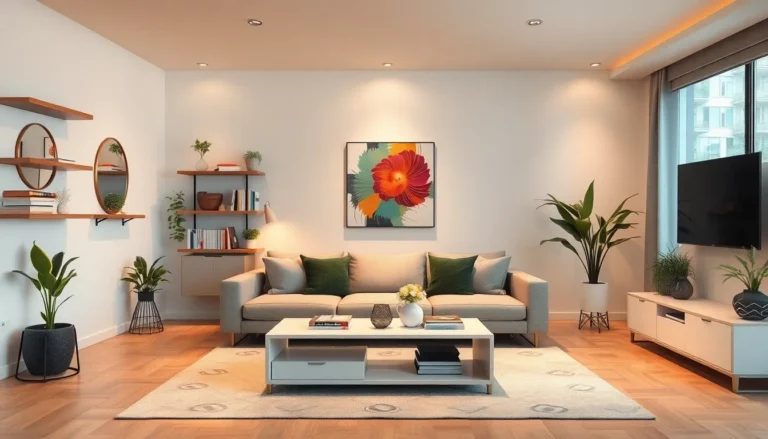Imagine stepping into a living room that effortlessly blends the warmth of traditional design with the sleekness of modern aesthetics. That’s the magic of transitional style interior design. It’s like having your cake and eating it too—who wouldn’t want the best of both worlds? This style invites comfort and sophistication, creating a space that feels both inviting and chic.
Table of Contents
ToggleUnderstanding Transitional Style
Transitional style blends traditional warmth with modern sleekness, creating inviting living spaces. This design approach appeals to those seeking both comfort and sophistication.
Defining Transitional Style Interior Design
Transitional style interior design serves as a bridge between classic and contemporary aesthetics. It emphasizes the elegance of traditional elements while incorporating the simplicity of modern design. Neutral color palettes frequently dominate transitional spaces, providing a serene backdrop. Integrating various materials enhances the overall depth and texture, allowing for visual interest.
Key Characteristics of Transitional Design
Transitional design showcases several key characteristics that define its unique appeal. Clean lines contribute to an uncluttered look while soft curves add warmth. Streamlined furnishings play a vital role in achieving a balanced atmosphere. Additionally, a mix of textures, such as wood, metal, and fabric, creates layered comfort. Lastly, subtle patterns can offer interest without overwhelming the eye, maintaining a harmonious flow throughout the space.
Elements of Living Room Transitional Style
Transitional style interior design focuses on blending traditional and modern elements seamlessly. Key elements enhance both comfort and sophistication.
Color Palette and Textures
Neutral colors such as beige, gray, and white dominate the transitional living room. These shades create a calming environment. Incorporating textures adds depth to the overall look. Soft fabrics like linen or cotton bring warmth, while sleek metals and polished woods introduce a modern touch. Layering different materials helps maintain visual interest without being overwhelming. Subtle patterns on pillows or rugs can enhance the inviting atmosphere without detracting from the serene color scheme.
Furniture Selection and Arrangement
Furniture selection emphasizes clean lines and simplicity. Sofas often feature soft curves for added comfort. Chairs and tables should complement these shapes, maintaining a balanced look. Arrangement plays a crucial role in functionality. Grouping pieces fosters conversation, while open spaces promote flow. Incorporating multi-functional pieces maximizes utility, which is ideal for varied activities. A cohesive layout allows for easy movement and enhances the overall aesthetic of the living room.
Incorporating Accessories in Transitional Living Rooms
Accessories play a vital role in enhancing transitional living rooms. They infuse personality and warmth into the space while upholding the design’s balanced aesthetic.
Art and Décor
Art selections showcase the unique blend of traditional and contemporary styles. Abstract paintings or classic landscapes complement the neutral palettes frequently found in transitional rooms. Sculptures made from wood or metal add depth and intrigue, capturing attention without overwhelming the senses. Wall décor, such as framed mirrors, can enhance light and create an illusion of space. Textiles like throw pillows or area rugs introduce subtle patterns, tying together color schemes without disrupting the serene ambiance.
Lighting Solutions
Lighting solutions must contribute to both function and aesthetic. A mix of sources, such as floor lamps, table lamps, and overhead fixtures, builds layers of illumination. Statement light fixtures featuring modern designs maintain a sleek look while complementing traditional elements. Warm-toned bulbs offer a cozy atmosphere, making the space inviting for gatherings. Dimmers allow for adjustable lighting, facilitating different moods throughout the day. Accent lighting highlights artwork or décor, drawing the eye and adding character.
Tips for Achieving a Transitional Look
Achieving a transitional look in a living room involves thoughtful integration of traditional and contemporary elements.
Mixing Traditional and Contemporary Styles
Start with foundational pieces that embody the transitional design ethos. Sofas with clean lines paired with traditional chairs create a balanced vibe. Incorporate a combination of wood and metal in furnishings, blending warmth with modern sleekness. Artwork plays a crucial role, so select abstract pieces that resonate with both styles. Use elegant areas rugs to define spaces, showcasing subtle patterns without overwhelming the eye. These choices create a visual dialogue between old and new, ensuring harmony.
Creating a Cohesive Space
Establishing a cohesive space requires attention to color palettes and material selection. Utilize neutral shades like beige and gray as a base, ensuring a calm and inviting environment. Arrange furniture for functionality, promoting easy conversation and unobstructed movement. Select accessories that echo the color scheme, reinforcing continuity throughout the room. Incorporate textiles in various textures, such as soft throw pillows or warm blankets, to add layers of comfort. These methods enhance the overall aesthetic while maintaining a refined, uncluttered look.
Transitional style interior design offers a unique blend of tradition and modernity that appeals to many homeowners. By creating a living room that balances comfort with sophistication, it invites relaxation while maintaining an elegant atmosphere. The thoughtful integration of textures, colors, and furniture arrangements fosters an inviting space perfect for gatherings.
Emphasizing neutral palettes and layered materials enhances the room’s overall aesthetic, ensuring it remains both chic and functional. With careful attention to detail in accessories and lighting, a transitional living room becomes a reflection of personal style while promoting a serene environment. This design approach truly embodies the best of both worlds, making it a timeless choice for any home.








